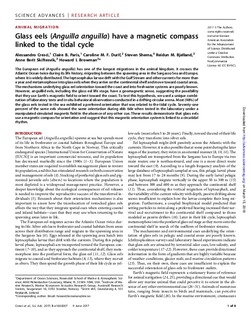| dc.description.abstract | The European eel (Anguilla anguilla) has one of the longest migrations in the animal kingdom. It crosses the Atlantic Ocean twice during its life history, migrating between the spawning area in the Sargasso Sea and Europe, where it is widely distributed. The leptocephalus larvae drift with the Gulf Stream and other currents for more than a year and metamorphose into glass eels when they arrive on the continental shelf and move toward coastal areas. The mechanisms underlying glass eel orientation toward the coast and into freshwater systems are poorly known. However, anguillid eels, including the glass eel life stage, have a geomagnetic sense, suggesting the possibility that they use Earth’s magnetic field to orient toward the coast. To test this hypothesis, we used a unique combination of laboratory tests and in situ behavioral observations conducted in a drifting circular arena. Most (98%) of the glass eels tested in the sea exhibited a preferred orientation that was related to the tidal cycle. Seventy-one percent of the same eels showed the same orientation during ebb tide when tested in the laboratory under a manipulated simulated magnetic field in the absence of any other cue. These results demonstrate that glass eels use a magnetic compass for orientation and suggest that this magnetic orientation system is linked to a circatidal rhythm. | nb_NO |
